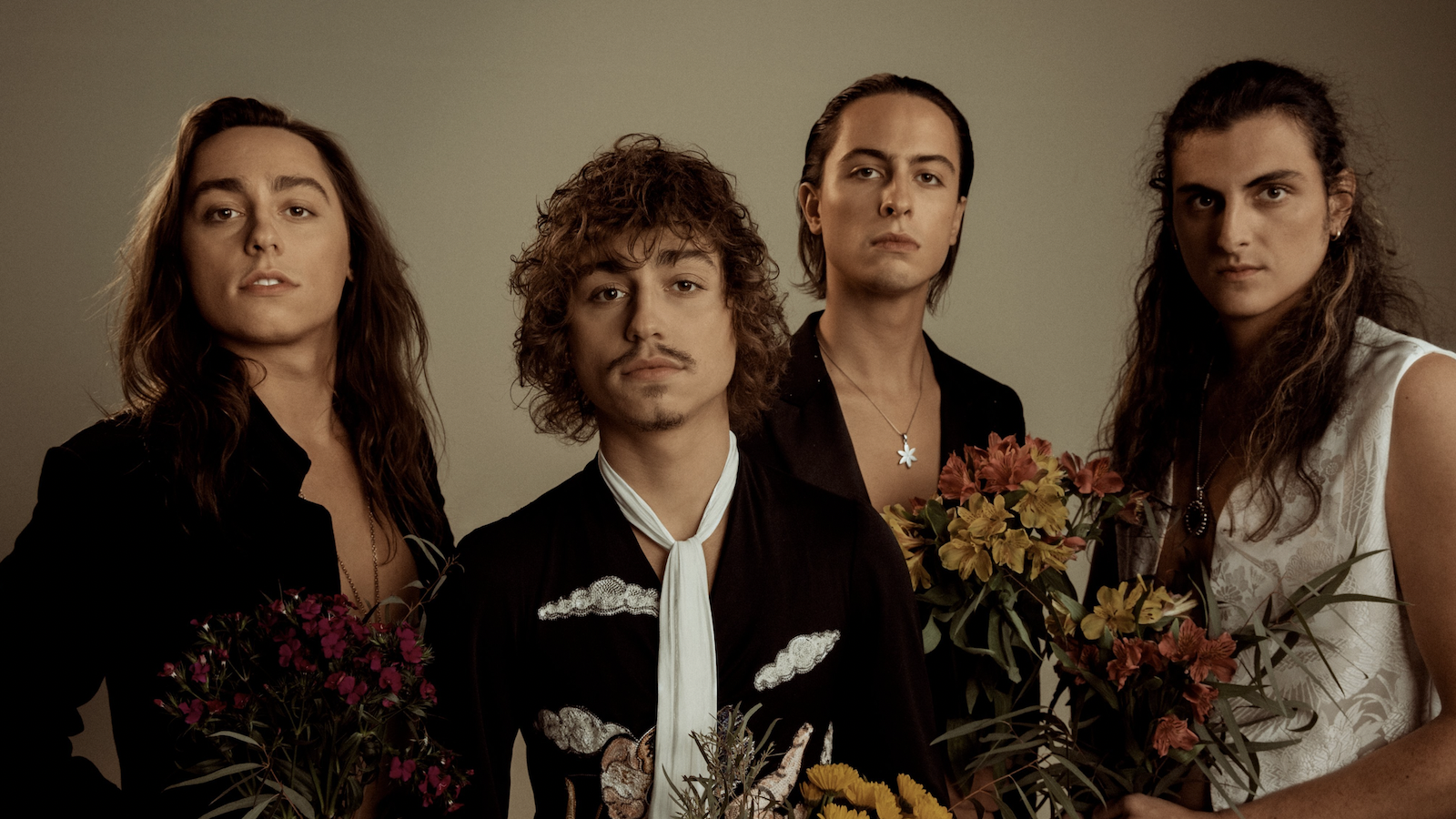Greta Van Fleet’s Jake Kiszka: “We wanted to create something orgasmic and cinematic”
On LP2, the Kiszka brothers' love of film collides with their talents in rock 'n' roll

Note: this article is also featured in Australian Guitar #142, which is out now wherever great magazines are sold.
If there’s one thing filmmakers like Christopher Nolan understand (because it certainly isn’t storylines that make sense – did y’all see TENET!?), it’s the importance of music to make gripping action scenes and grandiose set pieces feel all the more intense. A good film score can be the difference between a bargain-bin flop and an Oscar-winning classic – especially in the hands of a prodigious composer like Hans Zimmer or John Williams.
But what if you flipped the script (pun intended) and approached a non-visual music project with the ethos of cinematic filmmaking? Of course rock operas are nothing new in 2021, but what if you went beyond the typical structure of one, and treated it as though you were scoring a blockbuster epic that didn’t exist?
These are the questions Greta Van Fleet set out to answer with their bold and bombastic second album, The Battle At Garden’s Gate. Following 2018’s critically adored Anthem Of The Peaceful Army, the hard-rocking heavyweights looked to up the ante a thousandfold – the riffs are bigger, the hooks are catchier, and the solos are more ball-strainingly insane. If they keep progressing at the rate they are now, we’re scared their next album will end up banned for causing widespread heart attacks from its sheer intensity.
As guitarist Jake Kiszka fills us in, The Battle At Garden’s Gate is the result of years spent honing the band’s craft, and proof that sometimes getting a bit ahead of yourself in the conceptual stages of a project can really pay off.
What did you learn from making Anthem Of The Peaceful Army that informed how you wanted to approach this record?
I think there were some characteristics of our playing and style on that album that we identified with, and some of those carried over. But ultimately, once you’ve created and released a record, it lives in a past space. So as much as some of our earlier characteristics did inform this record, it also kind of informed itself to a certain degree. The album evolved as we wrote it; we had some objectives that we wanted to try executing on this album, like the ambition to create something that was vastly dynamic and very dense. We wanted to create something orgasmic and cinematic – which I guess is an ode to a lot of what our childhood was like. We were raised in a house that wasn’t just super musically influential, but also literarily and philosophically. We were inspired by a lot of film and visual media, and a lot of those elements went into the creation of this album.
You can tell by the title alone that when you put this record on, you’re in for a pretty cinematic journey.
For sure. And as soon as we had the idea for a rock ’n’ roll album that had this sort of cinematic aura fixed around it, I started listening to a lot of Hans Zimmer. We’d go up into the countryside, or somewhere like Chattanooga, Tennessee, and we’d be writing, and in-between sessions I would just be hanging out and listening to Hans Zimmer scores. So I’m sure some of that informed part of the writing.
Get The Pick Newsletter
All the latest guitar news, interviews, lessons, reviews, deals and more, direct to your inbox!
In terms of your technicality – in particular, your soloing technique – how did you want this record to reflect your evolution as a player?
I definitely wanted to challenge myself. Blues would be my dominant influence as a player, and I suppose our primary influence as a collective. So I asked myself, “Okay, how do I apply these blues elements to what we do, and something cinematic, and something rock ’n’ roll?” It was kind of challenging, but I guess it’s also kind of symphonic in that same sense – the guitar is playing a melody, and you can apply that to music in orchestral sense as well, because orchestral music is both very melodic and cinematic. A lot of the melodies I was writing for the guitar were crafted in the mindset of wanting them to sound more like a violin, or a more symphonic instrument. I think that helped me navigate through some of those challenges.
The guitar and violin are two very different instruments, but you can approach them both in very similar ways.
I think so! I’ve always seen the guitar and violin being two very common sort of instruments – not so much in a physical sense, but more in a melodic sense.
I remember when the last album came out, you were all about this beautiful ’61 Les Paul SG. Is that still your daily driver?
Yeah! I used that mainly on the album. It’s something I’m very used to. My first guitar was an SG with P-90s on it – it was actually the same type of model Pete Townshend would play – so I was drawn to the ’61 Les Paul because of the similarities to that. There was one other really cool guitar that I was able to use on this album, which was a 1959 ES-335. It was factory black, and there are only something like six of those in existence – that we know of, at least. And that was pretty crazy – I just had a friend hop in and be like, “Hey, do you want to use this?” And I was just like, “Dude, are you kidding me!?” I think Keith Richards has one, Johnny Marr has one, and John Shanks has one… Yeah, it was a really cool experience to play something like that.
It’s one of those rock ’n’ roll holy grails!
Yeah, it’s one of those types of guitars you’d only ever expect to see in a museum, except I got to actually play one. It was pretty outrageous.
Do you reckon part of that Les Paul’s charm is that you’ve kept everything stock and let it live the rock ’n’ roll life that Gibson set it out for all those decades ago?
I guess it’s like an old car – it still runs the way it was built to run. There weren’t any corners cut, and you can hear the life it’s lived in that sense. I mean, I absolutely brutalise the poor bastard every once in a while, it’s pretty beat-up, but it sounds amazing. I suppose the guitar had to take that journey, though – it had to really live a life to have the kind of voice it does.
Guitars are made for playing, man.
Exactly! That’s the philosophy I have behind every guitar I get my hands on. Like what do you want to do, put it in a case and hang it on the wall? What’s the point of that!?
So when can we expect to see your name on a signature model?
I’ve been thinking about it! But I don’t know – I’d have to conceptualise it first, I guess, so who knows when that day will come?

Ellie Robinson is an Australian writer, editor and dog enthusiast with a keen ear for pop-rock and a keen tongue for actual Pop Rocks. Her bylines include music rag staples like NME, BLUNT, Mixdown and, of course, Australian Guitar (where she also serves as Editor-at-Large), but also less expected fare like TV Soap and Snowboarding Australia. Her go-to guitar is a Fender Player Tele, which, controversially, she only picked up after she'd joined the team at Australian Guitar. Before then, Ellie was a keyboardist – thankfully, the AG crew helped her see the light…
"They said, 'We don't have a direction yet, but you got the gig!' I said, 'Well, let me think about it'": Yngwie Malmsteen on why he turned down UFO
“I loved working with David Gilmour… but that was an uneasy collaboration”: Pete Townshend admits he’s not a natural collaborator – even with bandmates and fellow guitar heroes








![[from left] George Harrison with his Gretsch Country Gentleman, Norman Harris of Norman's Rare Guitars holds a gold-top Les Paul, John Fogerty with his legendary 1969 Rickenbacker](https://cdn.mos.cms.futurecdn.net/TuH3nuhn9etqjdn5sy4ntW.jpg)
